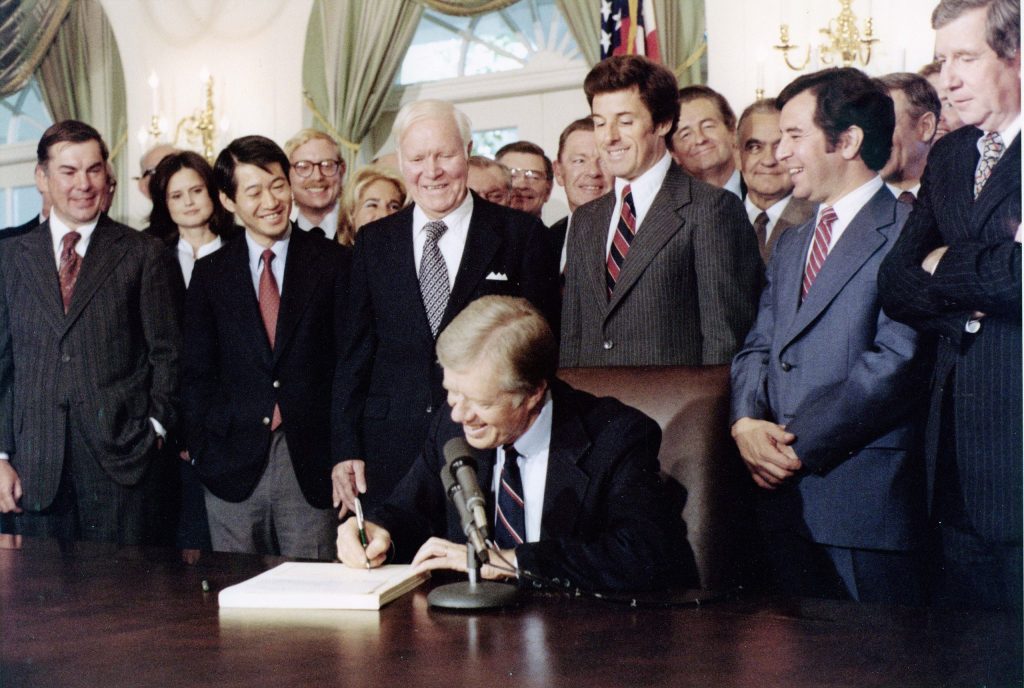Washington, D.C. — If you’re an infrastructure and transportation policy wonk, you may have heard of the Staggers Rail Act of 1980—the foundational piece of federal legislation that saved freight railroads from ruin four decades ago and catalyzed a U.S. freight rail renaissance that continues today. On the other hand, the casual railfan or observer might not be aware of this seemingly obscure federal policy that helped build today’s nationwide freight rail network.
As we lead up to and celebrate the 40th anniversary of the Staggers Act, we’ve laid out some of the basics—a roadmap to this legislation and why it matters today.

What is “Staggers”? Enshrined on October 14, 1980 with a signature from President Carter, the Staggers Rail Act—named for its lead sponsor, West Virginia Rep. Harley Staggers—is a federal law that deregulated certain economic aspects of freight rail, freeing railroads to negotiate with customers on service and pricing.
What did it mean for freight railroading? In a nutshell, it removed barriers that had previously regulated day-to-day operational aspects of railroading like rail routes and rates, allowing rail companies to act like other businesses rather than government-controlled entities. This balanced approach to rail policy saved a dying industry by enabling railroads to earn enough profit to reinvest into expensive infrastructure costs.
Still going strong, 40 years later: We’re celebrating the anniversary of Staggers because it’s smart policy that still works—and we want to ensure that policymakers at the federal level recognize its successes. One of these successes is the sheer amount of private spending by railroads on their networks since 1980, over $710 billion. That’s six times the rate of the average manufacturer. And it matters to communities because that money fosters economic growth at the local level.
Deregulation Done Right: Railroads today are still highly regulated by the federal government, and shippers are still protected by the tenets of Staggers. This balance of railroad and customer interests is why Staggers continues to work so well. Since 1980, rail rates for shippers have decreased 43% on average when adjusted for inflation. Rail productivity has also doubled, meaning the average rail shipper can move more freight for around the same price it paid 40 years ago.
Why it matters right now: Certain groups, namely big shippers, are always looking for ways to cut the rates they pay, even if this means undermining the networks on which they rely. At stake currently are several proposals before the U.S. Surface Transportation Board that could cap rail rates, or even compel railroads to open their private lines to competitors.
The bottom line: While shipper groups calling for re-regulation say such changes will help competition, they’re actually asking the government to intervene on their behalf by mandating lower rates that the market doesn’t support. This would ultimately undermine rail’s ability to invest and compete with other modes.
Resilience is the word: “One of the things I’m most proud of is that, unlike a lot of other industries, we have not had to go to the federal government seeking direct funding or financial support,” said Association of American Railroads President and CEO Ian Jefferies during a recent webinar. Rail’s resilient response to the 2020 coronavirus pandemic is Exhibit A showing how Staggers has worked—both for the nationwide rail network and the communities that rely on its connections.
Celebrate with us: Follow GoRail on social media (Twitter, Facebook and LinkedIn) and share #Staggers40 articles and posts, tagging your members of Congress when possible.


